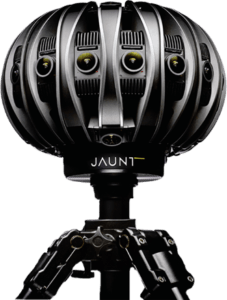Jaunt – Making the Shift from Product to Platform in VR

High end VR camera company looking to make the shift from product to platform for content creation and distribution
Jaunt, founded in 2013, has developed technology to enable developers of content to create virtual reality experiences that offer significant improvements in quality, immersion and experience for users. As discussed in our background reading, one of the major challenges in the transition to VR is the need for content and content creation tools which will be necessary to entice users to spend hundreds of dollars on devices, such as Oculus Rift, Gear VR, HTC Vive or Google Cardboard. For many content and media companies, the ability to port over “old” media will be challenged in this new environment, given the higher needs and expectations of customers.
Jaunt creates value by offer a professional quality, cinematic VR camera which allows for 360 degree capture and specialized lens that allow for the recording of content in ways that were not previously needed. Their product, the Jaunt ONE (J1-24G), will allow for better capture, processing and publishing of content that will be needed to solve the chicken and egg problem of VR. In addition to their core product, Jaunt offers software complements which allow for greater control and operation of the device, as well as services that allow for media management, editing, playback and storage.
Through the Jaunt application, the company also appears to be entering into the platform business of distributing content to users. Given the rising power of platforms, it is not surprising that a company with specialties in hardware would look to leverage their product to create a community of users around their community of content providers. While I anticipate VR headset manufacturers may compete head-to-head in this arena, the potential upside for Jaunt is massive if they are able to develop strong network effects based around their leadership in VR content creation.
Currently, Jaunt captures value primarily through the sale and rental of their cameras, which are offered at rental prices north of $4,000 per day. Many other companies, including GoPro and Nokia offers similar hardware with differing degrees of quality, functionality, size and price. Jaunt primarily sells their product through reseller networks, including companies such as AbelCine, Studio-B&H and Radiant Images. Long term, it appears that Jaunt will seek to also capture value through their content viewing platform, either through data sales, advertising or some other means.
As discussed in class, the key to Jaunt’s success will be the development and transition to a platform model that can capture value sustainably over time. Currently, the company allows content providers to submit content, with lists of product guidelines, ranging from quality to movement to audio format that help creators to determine what users are looking for and improve their marketability to consumers. Jaunt also acts as a curator, with content guidelines aiming to solve problems of violence or hate speech, which have caused large headaches for giants, like Facebook, recently. Jaunt also offers a number of services to content creators in order to subsidize and enhance their use of the platform. From marketing support, to platform compatibility to cloud upload capabilities, Jaunt is making it a priority to attract high-quality content onto their platform.
In line with our discussions of platforms, I believe that this emphasis on creating significant value for the content side of the platform will be key in the upcoming VR ‘war.’ While I believe their strategy related to developer tools is great, I have more questions about whether hardware pricing will stymy their ability to attract enough users. I believe Jaunt should consider selling their technology at, or below, cost or offering rebates if content is limited to use on their platform. In this way, Jaunt could further expand the supply side of their user base, conquer the chicken and egg problem and begin the process of building user demand.
Sources:
http://www.theverge.com/a/best-vr-headset-oculus-rift-samsung-gear-htc-vive-virtual-reality
https://filmora.wondershare.com/virtual-reality/vr-content-developers.html
https://www.jauntvr.com/creators/submissions/benefits/
https://www.jauntvr.com/jaunt-one/
https://filmora.wondershare.com/virtual-reality/top-10-professional-360-degree-cameras.html
http://www.theverge.com/2016/6/28/12041542/jaunt-one-virtual-reality-camera-rental-radiant-images




Great post, Dan! In my post about London’s Royal Opera House I wrote about an immersive film created in partnership with Jaunt using the Jaunt ONE camera. Your point about Jaunt trying to move from a product to a platform for content creation and distribution was interesting. YouTube and other video platforms like it are trying to build out their own capabilities for the production and distribution of VR content. What do you think it will take for companies like Jaunt to create their own platforms and challenge big incumbents in the video space for viewership?
Great post Dan! I have watched a bunch of Jaunt videos on an Oculus Rift headset, and they are very cool! The Jaunt camera is great for recording live events such as concerts and sporting events, allowing fans to watch the event as if they were on stage or on the sideline. I have also heard that Jaunt’s software has significantly shortened the time required to stitch together the images captured from each camera to prep the 360-degree video for VR watching, improving the lag problem of prepping a video after an event. I agree that Jaunt should try to be a platform rather than just a camera product, but I wonder if Jaunt will be able to be a consumer facing brand or if Jaunt will stay behind the scenes of its content partners.